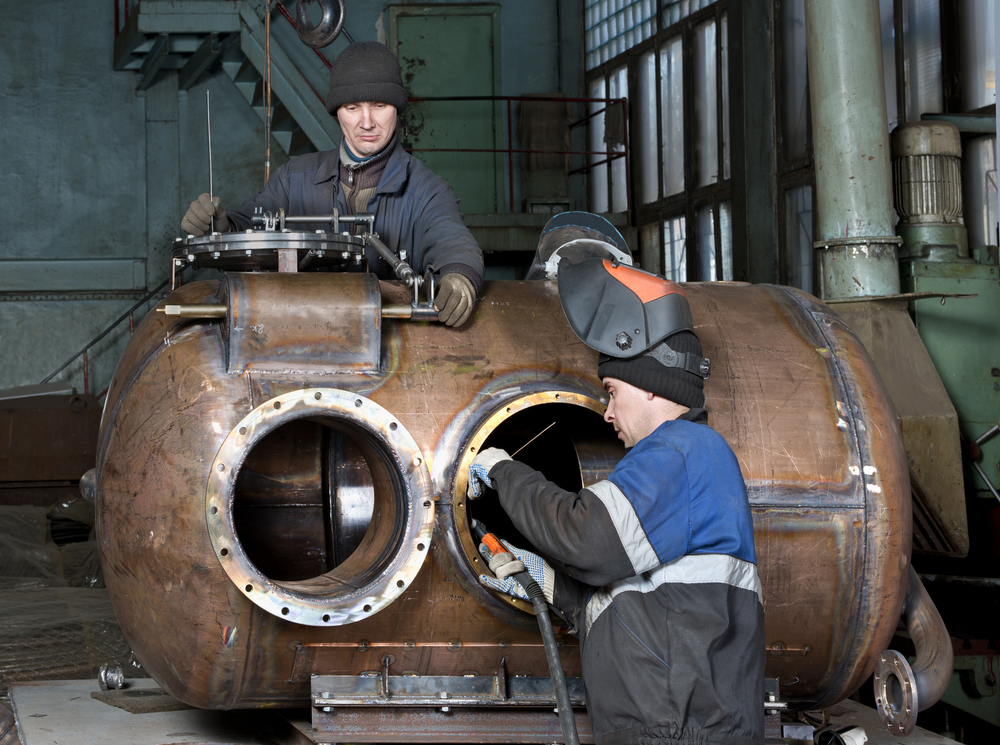A college education is often publicized as the only way to a promising career, but high paying jobs without a degree exist if you know where to look. We uncovered a number of jobs, from a variety of industries, that offer high pay for people with little to no education. Through research offered by the United States Department of Labor’s Occupational Outlook Handbook (OOH), we uncovered a number of high-paying jobs with no experience and some of the best jobs without a college degree. Our data was taken from the OOH, and duties, education, training, and median pay were detailed below. Most of the jobs on our list require only a high school diploma or its equivalent. The jobs take place in and out of the office, often including fieldwork or labor outside of a cubicle, and are considered to be fun jobs that pay well without a degree. Some of the occupations on our list require physical labor and a particular set of skills that can’t be learned by working other jobs. For example, boilermakers and fire inspectors have a particular skillset unlike other occupations. Specialized on-the-job training for these positions may be required. Top-Paying Jobs Without A Degree While salary is a major factor when applying for a job, other considerations should be factored. We examined high paying jobs without a degree that offered favorable employment growth and a positive job outlook. While not all jobs that made our list showed an increase in hiring and a boom of new jobs on the horizon, many did. We also considered what factors impacted employment growth or decline. Certain jobs were impacted by automation and technology, thus seeing a decline in employment growth. Others saw an increase due to expansion in the industry and an improving economy. Of the 20 jobs listed here, only one showed a considerable decline in job growth, which is due to the changing times and an industry that is being greatly impacted by this evolution. Below we list our findings and some of the best jobs without a degree for those with little to no education.
#20 – Water Transportation Workers

Median annual wage:
$54,400Number of Jobs:
83,400Employment growth rate:
-2.0% Water transportation workers are responsible for the maintenance and operation of vessels that haul people and cargo over water. Training varies according to vessel and job type, but sailors and marine oilers usually do not need more than a high school education or its equivalent. U.S. Coast Guard-approved training programs help individuals obtain required credentials for most other water transportation occupations. As of 2018, 83,400 water transportation worker jobs fell under this category. While the occupation is showing a decline of two percent, the decrease in employment growth is not occurring as fast as other jobs. Fluctuation in demand for cargo and bulk commodities seems to be a critical factor influencing employment of water transportation workers. While this occupation offers a steady income, cutbacks could impact the hiring of new employees. States with the highest published employment for water transportation workers, according to BLS, include coastal states such as Florida, Louisiana, Texas, New York, and Virginia. Other states that employ high numbers of water transportation workers include Alaska, Washington, Oregon, and New York. Job prospects for this job without a degree can be better in any of these states, as individuals retire and openings must be filled.#19 – Telecommunications Equipment Installers and Repairers
Median annual wage:
$56,100Number of Jobs:
232,900Employment growth rate:
-6.0% Telecommunications equipment installers and repairers set up, maintain, and operate various devices that carry communications signals. Most jobs require a high school diploma or its equivalent and moderate on-the-job training. For supervisory roles in this field, postsecondary education may be required in disciplines such as computer technology, electronics, or telecommunications. The median annual wage for telecommunications equipment installers and repairers is $56,100 or $26.97 per hour. While the annual wage is strong, the employment outlook will see a six percent decline over the next nine years. As consumers demand wireless and mobile services, less installation is required. Individuals with specialized telecommunications training will see the best job prospects. According to BLS, states and areas with the highest published employment and wages of telecommunications equipment installers and repairers include California (34,080), Texas (23,340), Florida (19,660), New York (10,520), and Georgia (9,520). For individuals willing to relocate to any one of these states, the job prospects might be greater than in other areas of the country for this high-paying job that doesn’t require a college degree.#18 – Court Reporters
Median annual wage:
$57,150Number of Jobs:
15,700Employment growth rate:
+7.0% A court reporter creates transcriptions at trials and other legal proceedings. Most court reporters hold a high school diploma and have received a few weeks of on-the-job training, but generally, no college degree is required. Some states require court reporters to have a state license or certification from a professional legal association, though this is not true of all states. Court reporters generally receive a few weeks of training while on the job. The annual median wage for a court reporter is $57,150 and the overall job outlook for this occupation is favorable. In fact, BLS reports employment of court reporters is projected to grow seven percent through 2028, slightly faster than all other occupation. Applicants with a related work history will fare well in the market. Also, those trained with special techniques, such as CART and other translation techniques will have the best prospects over the next several years. States with the highest employment level in this occupation include California, New York, Florida, Pennsylvania, and Indiana. In fact, California employs over 10 percent of all court reporters. This means relocating to one of these top-employing areas could offer favorable job prospects – no college education required.#17 – Electrical and Electronics Repairers
Median annual wage:
$57,890Number of Jobs:
124,100Employment growth rate:
-1.0% Electrical and electronics repairers are responsible for the repair and installation of electrical equipment. Most occupations take place in repair shops or in large factories. Repairers are required to lift heavy machinery and equipment and often work in awkward positions. The work is full-time and shifts generally call for overtime hours. A high school diploma or its equivalent is needed for electrical and electronics repairer occupations, but specializations may be required for advancement. Often apprenticeship training and work experience are required upon hiring. The average pay for this occupation, as of May 2018, is $57,890 or $27.83 per hour. Little or no change in the overall employment growth rate is projected through 2028, as the industry stabilizes. This growth rate may vary by specialty. The best qualified candidates for job opportunities will have experience or training in electronics.#16 – Electrical and Electronics Installers

Median annual wage:
$57,890Number of Jobs:
124,100Employment growth rate:
-1.0% Electrical and electronics installers are responsible for installing electrical equipment. Installers need at least a high school education, but many positions call for specializations and work experience; still, no college degree is required. Entry-level positions offer apprenticeship training to ensure installers have acquired adequate skills. The overall employment of electrical and electronics installers is projected to show little to no change over the next several years, but growth rates will vary by specialty. According to BLS, job opportunities will be favorable for the most qualified candidates. If you have special training in an area of electronics, be sure to showcase that expertise on your job application. The average annual wage for an electrical and electronics installer is $57,890.#15 – Fire Inspectors

Median annual wage:
$60,200Number of Jobs:
15,200Employment growth rate:
+8% A high school diploma or its equivalent and on-the-job training are required to land a position as a fire inspector, but no college degree is required; however, supervisory roles may need additional training and education. The role of a fire inspector is to examine buildings for fire hazards and ensure state, local, and federal fire codes are met. The fire inspector office is often the field, so if you desire not to be confined to a cubicle, this job is ideal. In 2018 there were 15,200 jobs listed under the category of fire inspector. The job outlook is favorable and employment of fire inspectors is expected to grow eight percent through 2028, faster than most other occupations. Due to this growth, applicants should expect competition as limited positions are available. The median pay for a fire inspector in 2018 was $60,200. According to BLS, states with the highest published employment of fire inspectors include Texas, New Jersey, New York, Florida, and Illinois. In fact, Texas employs 2,120 fire inspectors and investigators, offering the best job prospects for this occupation.#14 – Boilermakers
Median annual wage:
$62,150Number of Jobs:
14,500Employment growth rate:
+6.0% Boilermakers perform physically demanding work, as they are responsible for assembling, installing, and repairing boilers and other large vats or vessels that contain gas or liquid. A high school education or its equivalent is required for entry-level boilermaker occupations, though apprenticeship programs are part of the hiring process. Once hired, a new boilermaker can expect to spend four years in an apprenticeship. Individuals with welding experience or certifications are valued above those with no work experience. Employment for this occupation is projected to grow six percent, according to BLS, from 2018 to 2028. This growth is about as fast as all other occupations. Digging further into the employment growth rate, we found BLS reported five states where the highest employment for boilermakers occurred. Texas, Indiana, Louisiana, Ohio, and Florida were among the top states and areas with the highest published employment of boilermakers. Job opportunities exist in these states if an applicant is willing to relocate to one of these geographic locations.#13 – Aircraft Mechanics

Median annual wage:
$63,060Number of Jobs:
157,400Employment growth rate:
+3.0% The role of the aircraft mechanic is to repair and perform routine scheduled maintenance on aircraft and avionics equipment. The job requires no education, though entry-level jobs often call for a high school diploma or its equivalent. Some technicians and mechanics learn their trade at an FAA-approved aviation maintenance technician school, while others are trained on the job. It is not uncommon for minimal on-the-job training to take place upon hiring. The average annual wage for an aircraft mechanic is $63,060, while avionic technicians earn about one-thousand more. As of 2018, the job outlook for this occupation was slower than the average. A three percent increase in employment is expected through 2028. States with the highest employment, location quotients, and wages for aircraft mechanics occupations include Texas, Florida, California, Georgia, and Washington. In fact, Texas is the #1 state with employed aircraft mechanics, employing 17,160. For individuals looking for employment, relocating to these states could offer favorable job prospects.#12 – First-Line Supervisors of Correctional Officers
Median annual wage:
$63,340Number of Jobs:
45,900Employment growth rate:
-7.0% First-line supervisors of correctional officers are in charge of directly supervising and coordinating activities of jailers, correctional officers, and other correctional institution staff. As of 2018, there were 45,900 jobs that fell under this category. While the typical entry-level education is a high school diploma or its equivalent, work experience in a related occupation factors in when landing a first-line supervisor role. Between one and five years of work experience is necessary for an entry-level position, as there is little to no on-the-job training required, but this high-paying job doesn’t require a college degree. The median average wage for first-line supervisors in a correctional institution is $63,340, though the average pay varies by geographic location and facility security level. States and areas with the highest published employment, according to BLS, for first-line supervisors of correctional officers include California, Texas, New York, Virginia, and Florida.#11 – Detectives and Criminal Investigators
Median annual wage:
$63,380Number of Jobs:
808,700Employment growth rate:
+5.0% Detectives, police officers, and criminal investigators protect lives and property and gather facts and evidence related to crimes. Education requirements vary, but overall do not require a four-year college degree. In fact, most police and detectives have a high school diploma and considerable on-the-job training. These types of jobs do require the completion of the agency’s training academy before entering on-the-job training programs. The overall job outlook for police and detectives is favorable and steady. BLS reports a projected employment growth of 5 percent. This number is near the average for all other occupations and may vary by location and department. The median annual wage for police and detectives may also vary by location, but BLS reports the wage as $63,380 as of May 2018. In addition to favorable wages, states with the highest employment level in this occupation include Texas, California, New York, Florida, and Arizona. According to BLS, these states are more likely to hire and pay well for detective and criminal investigator occupations.#10 – Insurance Appraisers

Median annual wage:
$65,670Number of Jobs:
346,000Employment growth rate:
-4.0% Insurance appraisers, claims adjusters, examiners, and investigators fall under this category of occupations that evaluate claims. Most insurance appraisers work full time, often outside of an office, and inspect properties, such as buildings or vehicles, on which insurance claims have been reported. A high school diploma or its equivalent is generally required for individuals to work as entry-level insurance appraisers. The median annual wage for this occupation is $65,670 as of May 2018. According to BLS, the job outlook is projected to decline four percent from 2018 to 2028. As technology automates, some of the tasks once performed by insurance appraisers will no longer be needed. These tasks will be performed by computers and other technology. As a result, new hires for this occupation will continue to decrease. While the occupation is seeing a decline, insurance appraisers remain good paying jobs without degrees. If you are willing to relocate, the following states employ the highest number of insurance appraisers, claims adjusters, examiners, and insurance investigators – California, Texas, Florida, New York, and Pennsylvania. California currently employs the highest number (33,650) for this occupation that requires no college degree.#9 – Postmasters and Mail Superintendents
Median annual wage:
$75,970Number of Jobs:
13,300Employment growth rate:
-27.0% Postmasters and mail superintendents are compensated handsomely for their managerial duties, but the employment growth rate is on the decline. The median average annual wage for postmasters is approximately $76,000, but few positions exist. In fact, the growth rate is the lowest on our list. The Bureau of Labor Statistics expects there will be 27 percent fewer postmasters than there were working in 2018, which is one of the largest anticipated declines of any other career field. The projected decline is likely due to the changes in communication practices. More people send emails than physical letters, and the United States Postal Service is taking a loss in revenue as a result. While there is a steady decline in hiring new postmasters and mail superintendents, if you are willing to relocate to states with the highest employment level, you might find better job prospects for this high-paying job without a degree. These states include New York, Texas, California, Pennsylvania, and Illinois.#8 – Media and Communication Equipment Workers

Median annual wage:
$79,580Number of Jobs:
20,600Employment growth rate:
+8.0% Media and communication equipment workers typically need hands-on training and technical skills before entering this occupation, but very little education is required. Depending on the work they do, media and communication equipment workers may need to be mentored and undergo short-term on-the-job training. As of 2018, 20,600 jobs were occupied by media and communication equipment workers. The employment growth is favorable and is expected to increase by eight percent through 2028. As entertainment industries seek to improve media and communication capabilities, workers will be needed to set up, operate, and maintain equipment. The median annual wage will vary by geographic location and experience level. States with the highest number of media and communication equipment workers were California, Georgia, Colorado, Texas, and Maryland. In fact, California employs nearly half of all media and communication equipment workers. Individuals willing to relocate to California will have the best job prospects for this industry that pays well without requiring a degree.#7 – Elevator Installers and Repairers
Median annual wage:
$79,780Number of Jobs:
27,000Employment growth rate:
+10.0% Elevator installers and repairers have a unique set of skills that require them to work in tight spaces and cramped quarters. If you are not claustrophobic and like to work with your hands, this occupation might be of interest, and it doesn’t require a college education. The median annual wage for elevator installers and repairers, as reported by BLS in May 2018, is $79,780. Employment growth is favorable and expected to increase faster than the average for all other occupations. BLS reports 10 percent employment growth through 2028, as new commercial buildings that require elevator installation and service spur the demand for additional workers. Most elevator installers work full time, though emergency repairs may lead to overtime work. Depending on where and who a repairer works for, on-call hours may vary. Elevator installers remains one of the good paying jobs without degrees on our list. Job prospects in certain geographic locations are higher than others. If you are willing to relocate to states with higher employment numbers for elevator installers and repairers you may land a higher paying job. In fact, New York, Texas, California, Maryland, and Florida are the top five states with the highest employment for elevator installers and repairers. Most of these jobs are found in urban settings where growth and expansion occur.#6 – Power Plant Operators
Median annual wage:
$83,020Number of Jobs:
53,000Employment growth rate:
-6.0% Power plant operators are in charge of controlling systems that generate and distribute power. They use control boards to help distribute power and regulate the output of generators. Demands throughout the day may vary, thus power plant operators carefully monitor instruments to control voltage and electricity flows. To become a power plant operator, one needs only a high school diploma, though employers value individuals with strong math acumen and science backgrounds. The role of the power plant operator is a technical one, so having experience in algebra and trigonometry, as well as a solid grasp on electricity, helps. The employment growth rate for this occupation is on the decline. As focus shifts to efficiency and conservation, hiring for power plant operators has decreased. Currently there are 53,000 jobs for this occupation without a college degree. Of the number of jobs, certain states have higher prospects for power plant operators. In fact, BLS reports the top five states for the employment of power plant operators are California, Texas, New York, Michigan, and Florida. California currently employs 3,670 power plant operators.#5 – Power Distributors and Dispatchers

Median annual wage:
$83,020Number of Jobs:
53,000Employment growth rate:
-6.0% Power distributors and dispatchers work as controllers of systems that generate electric power. The typical education level for this occupation is a high school diploma or its equivalent, though long-term on-the-job training is a must. Hands-on training and some classroom education are likely required for entry-level power distributor and dispatcher jobs for this high-paying degree without college. The pay varies by location and years of experience, but the median annual wage, as reported by BLS, for power distributors and dispatchers in May of 2018 was $83,020 or $39.92 per hour. While the pay is considered high for the level of education required, the projected employment growth rate for new hires is on the decline. While electricity usage is expected to increase, technological advances and a greater emphasis on energy efficiency could hinder employment growth over the next several years.#4 – Nuclear Power Reactor Operators
Median annual wage:
$83,020Number of Jobs:
53,000Employment growth rate:
-6.0% Nuclear power reactor operators are responsible for the operation of systems that generate electric and/or nuclear power. Most operators work in rotating shifts, varying eight to twelve hours. A high school diploma is required for entry-level positions, though long-term on-the-job training is necessary. To land a job as a nuclear power reactor operator, one can expect a combination of hands-on training and classroom study at the job site. Background checks and drug and alcohol screenings are also required. Some nuclear power plant positions, especially those that impact the power grid, require certification through the North American Electric Reliability Corporation’s System Operator Certification Program. BLS reports a median annual wage for nuclear power reactor operators of $83,020, making it one of the high paying jobs without a degree listed here.#3 – First-line Supervisors of Police and Detectives
Median annual wage:
$89,030Number of Jobs:
121,600Employment growth rate:
+5.0% The typical entry-level education for first-line supervisors of police and detectives is a high school diploma or its equivalent. However, on-the-job training is the norm. Most first-line supervisors coordinate the activities of members of the police force and adequate training is necessary to do this job well. As a result, one to five years of experience in a related occupation will help you get the job as a supervisor of police and detectives. To land one of these high paying jobs without college, you will need to be adequately trained. According to BLS, there will be 5,800 new jobs added to this occupation and the employment growth rate will steadily increase at a rate of five percent through the year 2028. Also, as of May 2018, the median annual wage for this occupation is $89,030.#2 – Transportation, Storage, and Distribution Managers
Median annual wage:
$94,730Number of Jobs:
131,300Employment growth rate:
+6.0% Earning close to six figures each year, transportation, storage, and distribution managers land a top spot on our list of high paying jobs without a degree. Typical entry-level education required for these types of managerial occupations is a high school diploma, though relevant work experience is often needed. Employment growth for distribution managers is favorable over the next seven years, as reported by BLS. In fact, the growth rate is on par with the seven percent national average for all occupations. As of 2018, 131,300 positions fell under the category of transportation, storage, and distribution managers. Also included were logistics managers. Transportation and distribution managers are one of the best paying jobs without a degree.#1 – Commercial Pilots
Median annual wage:
$115,670Number of Jobs:
124,300Employment growth rate:
+6.0% Moderate on-the-job training is required for individuals to become commercial pilots. Commercial pilots, while highly skilled, need only a high school diploma and a commercial pilot’s license issued by the Federal Aviation Administration (FAA) to fly a plane. This is not the case for airline pilots, who usually need a bachelor’s degree and FAA-issued Airline Transport Pilot (ATP) certificate to fly. However, with a high school diploma and a commercial pilot’s license, you will be well on your way to becoming a commercial pilot. The job outlook, as reported by BLS, projects a six percent growth, which is slower than the national seven percent average for all occupations. However, as pilots retire over the next ten years, opportunities to replace these pilots will arise. States with the highest employment level for this occupation include Texas, Florida, California, Ohio, and Arizona, which means more job opportunities for individuals willing to relocated to these areas. Also, according to BLS, the annual wage mean is higher in these states. The median annual wage of $115,670 for commercial pilots makes it one of the high paying jobs without a degree on our list. Jobs That Pay Well Without a Degree Methodology To identify the best high paying jobs without a degree, we reviewed the median annual wages for occupations listed by the Occupational Outlook Handbook – Bureau of Labor Statistics (BLS). The most current wage data was taken from the Occupational Finder survey conducted on September 4, 2019. Most jobs on our list require only a high school diploma for entry into the occupation, while others ask for short-, moderate-, or long-term on-the-job training in the form of internships, apprenticeships, or other training programs. In some cases, such as transportation and distribution managers, no on-the-job training is required, while others such as commercial pilots require moderate training while on the job. Of the 20 occupations listed above, the median annual wage, job outlook or employment growth rate, and number of jobs in the industry were taken from the Occupational Outlook Handbook provided by BLS. Self-employed workers were not considered for this ranking. In some cases, we detailed the number of jobs for the occupation in particular geographic locations. We highlighted which states employed the largest numbers of selected occupation and which areas were more likely to hire than others. If you are willing to relocate to one of these areas for your chosen profession, job prospects improve. This is particularly important for occupations with a flat or decreasing employment growth rate, as new hires are on the decline.Related Resources:
Featured Programs
- A Guide to the Degrees and Schooling to Be a Pilot
- Is a Master’s Degree Necessary to Earn a Six-Figure Salary?
- What is a Non-Degree Program at a University?
- What Is the Best Degree Path for Becoming a Boilermaker?













